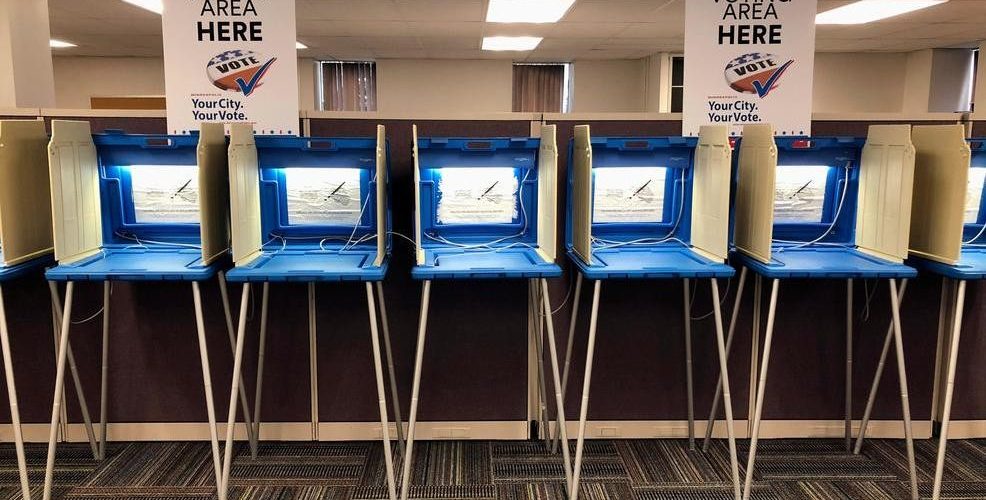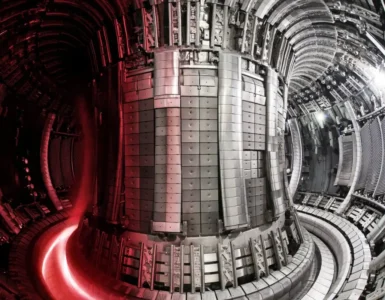by Karma Lei Angelo
The Voter
Evelyn stood in the voting line with the other citizens, waiting for it to slowly move forward. This was her first eligible election–and the nation’s first as a federal holiday, giving all residents the day off to head to the polls. Two older men ahead of her were discussing the candidates. She couldn’t help but eavesdrop when the conversation turned to ballots.
“And I heard they brought back the punch cards,” one said. “How do they really think that’s a good idea, with the hanging chads and all?”
The other man shrugged. “Well, isn’t it better than having those servers hacked again like the last election?”
“Meh, true. Can’t trust anything hooked up to computers these days.” The line inched forward. “But, still. Punch cards are no better. How many of the ballots get thrown out because they don’t work right?”
“And how many absentee ballots have been found in the trash or mailed to a dead person? Good thing the new system has done away with those,” the other argued. “At the end of the day, how many ballots really count? How many voters lose their voice?”
But how many voters lose their voice? How can the government make sure every vote counts? What will happen to mine? Her anxiety increased. Her stomach jumped into her chest. Why am I so nervous? They fixed the problems. The new system is supposed to be foolproof. No one even knows what to expect this year.
The official checked her identification and confirmed her registration. “Each office and position is listed on the machine. Colored chips are provided for each individual candidate. Use the appropriate chip to cast your vote. If you cannot see the colors due to monochromia or other eye disorders, the names of each candidate have also been placed on the chips. Once you are done casting your vote, a buzzer will sound indicating the chip has been logged. Do you have any questions?” Evelyn shook her head. “You are required to enter the booth now.”
She stepped in and shut the curtain behind her, staring at the table in front of her. Poker-like chips stood stacked across the table. Each a solid color, each with names etched inside. Each felt like it weighed the same. She looked at the slots in front of her and slid one of the chips in. It clinked and rattled as it landed somewhere below the table, locked away in a secured ballot box.
With all the technological advancements her country had seen in recent decades–and all the security precautions provided to ensure integrity of the new voting system–she wondered if such an antiquated method would work. And she still wondered if her voice would be heard.
The History of the Ballot
Why might a sophisticated and advanced society, such as this one, want to go back to a ballot-counting method, equitable to casting stones, millenia behind them? To understand this casting method, it’s important to understand a brief history of voting and how the process has changed over time.
Thousands of years ago, humans voted using the items they had around them at the time: sticks, shells, pieces of pottery, bone, and even stones. Stones, or ballotta, were a reliable method for centuries–hence the evolution of the word ballot. Paper ballots began to be used in the United States as early as the 17th Century; however, the young nation used viva voce, or “voice vote”, up until the early 19th Century. Mechanical lever machines began creeping into the picture in the 1890s and were a staple method for several decades. Punch-cards, computers, scanners, and direct-recording electronic (DRE) machines have since become popular.
Punch-cards were originally patented in 1889 and were used to compile data for the United States Census. It became a popular voting method for several decades after being introduced to voters in the 1960s. The punch-card device was a clipboard-sized handheld instrument. A voter would use a stylus to punch holes through a paper card that was then sent to a mechanical card counting machine at a centralized facility. However, the reliability of this system was markably questioned during the United States’ 2000 election when the presidential election came down to one state: Florida.
The candidates, Republican nominee George W. Bush and Democratic nominee Vice President Al Gore, were locked in a battle over a few hundred ballots in the state. Some news stations were calling Gore the winner in the swing state, thus fueling the idea Gore was now the projected winner for the presidency. But later that evening, reports came in that this was false and Bush had won. Lawyers were called in for both sides and a 5-week war over the voting process began. The “hanging chads” (only a portion of the perforated punch card had detached) and “dimpled chads” (the punch card area was dented instead of being removed) controversy–along with decisions from the courts going back and forth with each party–balloted its way to the US Supreme Court where Bush was finally given the ruling in his favor. Bush took the state by a 537 vote margin, winning the final electoral votes and the presidency.
After the 2000 controversy, the punch-card system faded from favorability and led to the Help America Vote Act (HAVA) of 2002. The act provided sweeping reforms to the voter process and improvements to the voting systems out there. Slowly, lever machines and punch-cards were replaced with DREs and optical scanners. See Figure 2: Voting technology usage over time in the U.S., from MIT’s Election Data + Science Lab below:
DRE voting systems started to become popular in 2004. They were easy-to-use touch-screen terminals which recorded votes. Votes were stored on memory devices or compact discs and transported to computers at a centralized location to be tabulated–much in the same way that paper-based ballots were done. In 2004, 28.9% of registered voters used some type of DRE system, up from 7.7% in 1996.
And optical-scan ballots became extremely popular. Nearly two-thirds of all registered voters now use optical-scanning methods as their standard voting system. Voters can fill in bubbles, complete arrows, or make machine-readable marks on paper ballots. The ballots are placed in a secured box and scanned as it is deposited. Votes are counted by running a procedure or program on the precinct scanner and then providing the totals.
However, new voting solutions also created newer voting problems.
The Modern Voice
Providing reliable voting systems and ensuring stable, secure results has proven to be harder than imagined. It’s a modern ballet of tiptoeing around the best method as hackers and fraudulent-minded individuals dance around flaws in the system.
Researchers began to question the reliability on paperless voting systems. Among them, David L. Dill, Ph.D., who called for “a voter-verifiable audit trail on all voting equipment”. He founded the Verified Voting Foundation (www.VerifiedVoting.org) to work on voting technology policy issues. According to their website, “voting systems and election infrastructure are vulnerable at multiple points and we must take steps to harden election technology of all kinds–not just voting machines–against tampering and failures.”
Among some of the issues with digital and electronic voting systems: lack of tangibility, no transparency, little standardization and testing, lack of quality control, and rampant voter fraud.
The lack of physical evidence of a vote was concerning. Dill and Verified Voting Foundation pushed for Voter-Verifiable Paper Audit Trails (VVPATs) for DREs. These pieces of paper looked like cash register receipts and documented if the computerized voting terminal worked properly, counting the vote. As of the 2016 elections, only one-third of DREs used VVPATs or had any auditing capabilities.
Lack of transparency is a problem, as recent as this year. Computer scientists do not have access to current electronic voting source codes and cannot determine if a program is functioning without errors. In the early months of 2020, a malfunctioning smartphone app crippled the Iowa caucus. While it was designed for more transparency into elections and tallies, dozens of Democratic precinct leaders and officials across the state could not download or log into the app to tabulate the results. The chaos brought concerns of election technology to the forefront.
There is a lack of standards, testing, and certification of current systems. Federal and/or state standards, which are typically several years old, have not caught up with the technology. Voting machine certification requirements vary quite a bit from state to state. The certification tests are typically done by vendors or an independent lab. This can be very costly and time consuming, in addition to misleading. While the hardware of a system can be verified, the software can still be hacked or software upgrades can be left up to the vendor, not covering necessary security precautions. In the aftermath of the Iowa caucus chaos, a technology company called Shadow was at the bottom of the app failure. The software went mostly untested and the Democratic officials have kept mute about how the app had been vetted and approved.
And software bugs in some voting machines have been known to alter or delete votes. For example, Texas voters in 2018 noticed that some DREs switched their vote from one candidate to another of a different political party. Computer sciences said it was a software error on the part of the voting machine, but election officials blamed voters, not the machines, for inadvertently touching the screens in the wrong place or while the system was still bringing the ballot on screen.
Perhaps even more disheartening and concerns is the problem of voter fraud, especially claims for the 2020 election. Voting technology is still subject to cyber attacks, being manipulated, and malfunctioning. At a DEFCON hacker conference in August 2019, attendees were given access to more than 100 voting machines. They were able to identify security issues and vulnerabilities in every single voting machine tested. Attendees were able to alter election totals, change the ballots, or control the software that controlled the machines. In addition, other studies and reports have concluded the same thing: voting technologies have “significant vulnerabilities that could be exploited”.
The Silent Absentee
And what about absentee, or mail-in, ballots? These first became widespread during the Civil War as President Abraham Lincoln stated, “We cannot have free government without elections, and if the rebellion could force us to forgo, or postpone a national election, it might fairly claim to have already conquered and ruined us.” Traditionally, these absentee votes were to help soldiers abroad have their voices heard. Now, and especially because of the pandemic, lawmakers are rethinking the remote voting process. In the 2020 election year, 34 states are allowing registered voters to cite COVID-19 as their reason to vote absentee.
However, according to the MIT Election Data & Science Lab, vote by mail (VBM) voter fraud, while extremely rare, appears to be more frequent than in-person voting. Voters in some states have mailed incorrect absentee ballots. Other states, such as Michigan, do not have the staff or machines necessary to process the sheer amount of ballots that come in. VBM ballots have also been found in a ditch in Wisconsin as well as discarded in Pennsylvania.
Would voter fraud be minimized by doing away with VBM ballots altogether? Perhaps not. VBM is not only more convenient for citizens, but it potentially provides more safeguards for voters. Consider the COVID-19 pandemic, for example. More than double the absentee ballots have been cast in 37 states in 2020 compared to the previous presidential election. VBM has already allowed millions of voters to be heard.
Even if VBM continues to gain in popularity, what about voting, in general? Will there ever be a technology at the polls that could guarantee complete accuracy that each vote counts and each voter’s voice is heard?
The American Association for the Advancement of Science (AAAS) has helped local, state, and federal officials with voting technology and security, and they have concluded that paper ballots–by either hand or machine–are the most effective method for casting votes because “the evidence tells us that no technology yet guarantees the security and secrecy of Internet voting.” Who’s to say that a more archaic method than paper–such as using shells, stones, or poker chips–is an even more secure way of counting a legitimate vote? Perhaps the future of voting relies more on non-futuristic technologies.
Perhaps the best voting method is behind humanity, instead of in front of it.









